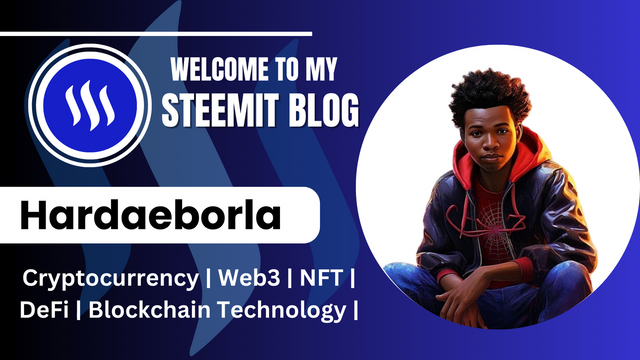What Are Ethereum Blobs and How Can They Be Used on The Graph

Hello Everyone!!! I hope you are having a great time over there? It's really nice to see you visit my blog today and I must say I'm really happy to have a great personality like you visiting my blog today 😊. Thank you once again 💕❤️
In the upcoming Dencun upgrade, Ethereum will incorporate EIP-4844 popularly known as proto-danksharding. This enhancement introduces type-3 transactions, offering fresh possibilities and complexities for Layer 2 networks to fine-tune their settlement processes with the base layer. In this blog post, we'll delve into the specifics of EIP-4844 and how they can be used on The Graph.
Understanding The Concept of Proto-Dank-Sharding

It's impossible to discuss Ethereum blob without mentioning Proto-Dank-Sharding, as they are closely intertwined.
When it comes to Ethereum Blockchain, Sharding helps to divide the Ethereum network into smaller units, essentially creating smaller blockchains upheld by a rotating group of validators. This approach reduces the burden of storing data on the Ethereum blockchain. Though it holds promise for significantly enhancing Ethereum network scalability and it also necessitates several intricate upgrades, posing risks if implemented all at once.

Proto-Dank-Sharding which is also known as EIP-4844 is an impending upgrade on the Ethereum Blockchain which is poised to tackle scalability challenges encountered by Layer 2 networks. It introduces type-3 transactions and blobs, presenting avenues for L2 networks to enhance their settlement procedures and reduce transaction cost. Proto-danksharding implements the majority of the necessary changes for true sharding without actually sharding the Ethereum Network.

According to The Blockchain Guy, the Sharding proposal on the Ethereum Blockchain was initially introduced by Dankrad Feist, a researcher at the Ethereum Foundation. Hence, the term "Dank Sharding" originated from Dankrad Feist's proposal.

Additionally, Protolambda, commonly recognized as Proto.Eth, and known for contributions to the Ethereum Blockchain, collaborated with Dankrad Feist in implementing Sharding on the Ethereum Blockchain, leading to the term "Proto Dank Sharding".
What Are Ethereum Blobs?

Ethereum Blobs are sizable data packets or data chunks integrated into Ethereum transactions with the aim of decreasing the cost of rollup transactions and boost network scalability. They serve serve as affordable, short-term memory holding transaction data which helps to carry transactions on the Ethereum Blockchain to enhance efficiency of transaction verification.

Ethereum Blobs are also known to be utilized by L2 networks for settlement instead of calldata. With EIP-4844 upgrade, each block can hold up to six blobs, and each type-3 transaction may contain one or two blobs making it capable of storing up to 128kb of data each. Notably, even if the allocated 128kb isn't fully utilized, the transaction sender is charged for the entire blob space.

Ethereum Blobs are mandated to be retained for 4096 epochs which is approximately equivalent to 18 days. This duration is deemed sufficient for all participants of an L2 network to access the data while ensuring manageable disk usage. Consequently, blobs are priced more affordably unlike calldata, which is mostly stored indefinitely.
Blob Gas

Blob gas will function as the transaction fee when conducting transactions via Proto Danksharding. As outlined in the proposal, the team intends to introduce blob gas as a distinct type of gas, separate from the conventional gas used on the Ethereum Blockchain as quoted below;
We introduce blob gas as a new type of gas. It is independent of normal gas and follows its own targeting rule, similar to EIP-1559. We use the excess_blob_gas header field to store persistent data needed to compute the blob gas base fee. For now, only blobs are priced in blob gas.
The implementation of EIP-4844 will establish two distinct fee marketplaces: one for Layer 1 execution and another for blobs, given that blob data doesn't align with the current Ethereum fee structure. While the supplementary fee marketplace will operate similarly to the current model in line with EIP-1559, the segregation ensures that congestion on the Ethereum network won't impact blob fees, enabling low fees even during periods of high network activity.
How Can Blobs Be Used On The Graph

There's definitely no doubt The Graph is known as a decentralized protocol designed for indexing and querying blockchain data. It facilitates querying of data that is otherwise challenging to access directly.
The good news is that users can now access, save, and query Blob data on The Graph with the support of Pinax and StreamingFast. According to a publication publication made by The Graph Foundation, accessing and querying Blob data on The Graph was enabled by integrating several pivotal technologies, including Firehose and Substreams, which collectively deliver a highly scalable solution for rapid extraction and processing of blockchain data.

Blob data on The Graph can be queried using two approaches. The first involves leveraging Ethereum Blobs Substreams to extract data directly from the Firehose-enabled Beacon Chain Substreams. The second method entails utilizing a Blobs Substreams-powered Subgraph to retrieve data from a Substreams-powered subgraph (GraphQL API) accessible on The Graph Network.
Ethereum Blobs Substreams
To access Blob data on The Graph, the first approach involves retrieving data directly from the Firehose-enabled Beacon Chain Substreams (gRPC API), as detailed earlier. This is accomplished by utilizing the Ethereum Blobs Substreams to handle blobs from consensus nodes. The existing Ethereum Blobs Substreams, in its basic form, processes data from the designated Firehose, extracting information from the beacon API (/eth/v1/beacon/blob_sidecars/{block_id}). Developers have the option to expand its functionality by incorporating additional Substreams modules for data transformation or employing alternative storage solutions.
You can test the new Ethereum Blobs Substreams by making use of Substreams.dev playground which gives you the opportunity to experience more about how this method works with Ethereum Blobs. Ensure you visit the link below to get started ;
https://substreams.dev/pinax-network/eth-blobs/v0.6.2
Blobs Substreams-powered Subgraph
This method of accessing and querying Blob data is my favorite due to its simplicity; Blob data is readily available on The Graph Network, as showcased in the provided link below;
Additionally, for further understanding, you can access the GitHub repository link. This indicates that additional subgraphs will be integrated into the network for EIP-4844 chains beyond the Ethereum mainnet (Beacon chain), ensuring a seamless decentralized experience.
Do You Have a Better Idea on How Ethereum Blobs Can Be Used on The Graph?

As The Graph is committed to meeting the needs of its users with its efficient data indexing and querying tools, you too can contribute to this significant advancement in the Web3 community. If you have any ideas or suggestions on how Blob data can be utilized on The Graph, feel free to share your insights on The Graph Forum through the provided link below;
https://forum.thegraph.com/t/blog-post-feedback-saving-the-blobs/5471
Also, for additional information and assistance on how you can utilize The Graph for blob data, please connect with the Edge & Node business development team through the form link below;
https://44585512.hubspotpagebuilder.com/the-graph-eip-4844-blob-data-form
Conclusion

Although the Dencun upgrade officially launched in the early hours of March 13, 2024, following its activation on the Ethereum mainnet at epoch 269568, it introduced the highly anticipated proto-danksharding functionality via EIP-4844. This upgrade seamlessly integrates off-chain "data-blobs," resulting in a significant reduction in the costs associated with storing transaction data.

By now, you're likely aware that The Graph stays at the forefront of modern Web3 development. While the Ethereum Blob proposal has been around for some years prior to Proto Danksharding gaining traction in the crypto space, The Graph swiftly integrated this advancement onto its platform, ensuring everyone can partake in the benefits of Blob Data within the Web3 community. We anticipate further developments and Web3 integration from The Graph, so be sure to stay updated with the community.
Reference Links
https://dailycoin.com/what-are-ethereum-blobs-how-do-they-boost-scalability/
https://www.theblock.co/amp/post/282236/ethereum-dencun-upgrade-blobs
https://www.altcoinbuzz.io/product-release/an-introductory-guide-to-ethereum-blobs/
https://www.blocknative.com/blog/eip-4844-blobs-and-blob-gas-what-you-need-to-know
About Me

I'm Adebola, a proud graduate in Agricultural Engineering (BSC). My passion for self-development and productivity drives me to constantly seek knowledge and conduct research. Over the last five years, I've immersed myself in the world of cryptocurrency and blockchain, growing more enthusiastic by the day. My diverse hobbies include reading, writing, enjoying good food, participating in agricultural activities, traveling, designing, and blogging. I possess a range of skills, including content writing, graphic design, UI/UX design, copywriting, internet marketing, research, data analysis, and basic coding. Don't hesitate to connect with me through the links below;
Telegram
Discord: Hardaeborla#103
Thank You for your time and I hope you have a great day ahead with love from @hardaeborla
💕❤️💕❤️💕
💕❤️💕❤️💕

Please Support the Project
.jpeg)
Special thanks to @crypto.piotr (Founder) and the team.
Learn more about Project Hope Community by clicking here here


Thank you, friend!


I'm @steem.history, who is steem witness.
Thank you for witnessvoting for me.
please click it!
(Go to https://steemit.com/~witnesses and type fbslo at the bottom of the page)
The weight is reduced because of the lack of Voting Power. If you vote for me as a witness, you can get my little vote.
Wow, what an insightful dive into Ethereum's upcoming upgrade and its implications for Layer 2 networks! The explanation of Proto-Dank-Sharding and its impact on transaction settlement processes is incredibly clear. The integration of Ethereum Blobs on The Graph seems like a game-changer for data accessibility and scalability. Your comprehensive breakdown and references make this a must-read for anyone interested in blockchain technology. Keep up the fantastic work, Adebola.